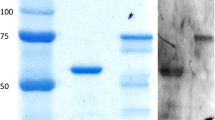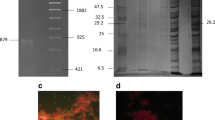Abstract
A total of 446 sera from 245 patients with primary or secondary infertility, all of whom were examined laparoscopically, 117 patients withChlamydia trachomatis-positive cervical swabs, and 84 control persons (50 obstetric patients and 34 female blood donors) were tested for antibodies toChlamydia trachomatis and toChlamydia pneumoniae with the microimmunofluorescence (MIF) test. MIF test antibody rates were highest in patients with complete tubal occlusion (73%) and in patients with provenChlamydia trachomatis infection (74%), whereas only 9 to 10% of the control group showedChlamydia trachomatis antibodies. Reaction to the 60 kDa antigen ofChlamydia trachomatis, a heat-shock protein (hsp) analogue, has been suggested as a possible marker for the development of chronic sequelae afterChlamydia trachomatis infection. Immunoblot analysis of 222 sera (169 infertility patients, 20 antigen-positive patients, and 33 mothers) showed a significantly higher anti-hsp antibody rate in patients with complete tubal occlusion than in infertility patients with normal fallopian tubes (76% vs. 19%, p<0.001). The presence of antibodies not only toChlamydia trachomatis but also toChlamydia pneumoniae in the MIF test was associated with a significantly higher rate of anti-hsp antibodies and with complete tubal occlusion. This association did not appear to be due to cross-reactivity betweenChlamydia pneumoniae and Chlamydia trachomatis antibodies in the MIF test.
Similar content being viewed by others
References
Paavonen J: GenitalChlamydia trachomatis infections of the female. Journal of Infection 1992, 25, Supplement 1: 39–45.
Cates W, Wasserheit JN: Genital chlamydial infections: epidemiology and reproductive sequelae. American Journal of Obstetrics and Gynecology 1991, 164: 1771–1781.
Anonymous: Ectopic pregnancy —United States 1990–1992. Morbidity and Mortality Weekly Report 1995, 44: 46–48.
Brunham R, Maclean IW, Binns B, Peeling RW:Chlamydia trachomatis: its role in tubal infertility. Journal of Infectious Diseases 1985, 152: 1275–1282.
Witkin SS, Ledger WJ: New directions in the diagnosis and treatment of pelvic inflammatory disease. Journal of Antimicrobial Chemotherapy 1993, 31: 197–199.
Patton DL, Kuo CC, Wang SP, Halbert SA: Distal tubal obstruction induced by repeatedChlamydia trachomatis salpingeal infections in pig-tailed macaques. Journal of Infectious Diseases 1987, 155: 1292–1299.
Morrison RP, Lyng K, Caldwell HD: Chlamydial disease pathogenesis. Ocular hypersensitivity elicited by a genus-specific 57-kd protein. Journal of Experimental Medicine 1989, 169: 663–675.
Taylor HR, Maclean IW, Brunham RC, Pal S, Whittum-Hudson J: Chlamydial heat shock proteins and trachoma. Infection and Immunity 1990, 58: 3061–3063.
Lehtinen M, Rantala I, Aine R, Miettinen A, Laine S, Heinonen P, Teisala K, Punnonen R, Paavonen J: Evolutionarily conserved and species specific B cell epitopes in chlamydial 60Kd GroEL-like protein hypB. In: Mardh PA, La Placa M, Ward M (ed): Proceedings of the European Society for Chlamydia Research. Uppsala University Center for STD Research, Stockholm, 1992, p. 73–76.
Paavonen J, Lähdeaho ML, Puolakkainen M, Mäki M, Parkkonen P, Lehtinen M: Antibody response to B cell epitopes ofChlamydia trachomatis 60-kDa heat-shock protein and corresponding mycobacterial and human peptides in infants with chlamydial pneumonia. Journal of Infectious Diseases 1994, 169: 908–911.
Yi Y, Zhong G, Brunham RC: Continuous B-cell epitopes inChlamydia trachomatis heat shock protein 60. Infection and Immunity 1993, 61: 1117–1120.
Zhong G, Brunham RC: Antibody responses to the chlamydial heat shock proteins hsp60 and hsp70 are H-2 linked. Infection and Immunity 1992, 60: 3143–3149.
Wagar EA, Schachter J, Bavoil P, Stephens RS: Differential human serologic response to two 60,000 molecular weightChlamydia trachomatis antigens. Journal of Infectious Diseases 1990, 162: 922–927.
Cerrone MC, Ma JJ, Stephens RS: Cloning and sequence of the gene for heat shock protein 60 fromChlamydia trachomatis and immunological reactivity of the protein. Infection and Immunity 1991, 59: 79–90.
Brunham RC, Peeling R, Maclean I, Kosseim ML, Paraskevas M:Chlamydia trachomatis-associated ectopic pregnancy: serologic and histologic correlates. Journal of Infectious Diseases 1992, 165: 1076–1081.
Toye B, Laferriere C, Claman P, Jessamine P, Peeling R: Association between antibody to the chlamydial heat-shock protein and tubal infertility. Journal of Infectious Diseases 1993, 168: 1236–1240.
Witkin SS, Jeremias J, Toth M, Ledger WJ: Cell-mediated immune response to the recombinant 57-kDa heat-shock protein ofChlamydia trachomatis in women with salpingitis. Journal of Infectious Diseases 1993, 167: 1379–1383.
Yuan Y, Lyng K, Zhang YX, Rockey DD, Morrison RP: Monoclonal antibodies define genus-specific, species-specific, and cross-reactive epitopes of the chlamydial 60-kilodalton heat shock protein (hsp60): specific immunodetection and purification of chlamydial hsp60. Infection and Immunity 1992, 60: 2288–2296.
Kikuta LC, Puolakkainen M, Kuo CC, Campbell LA: Isolation and sequence analysis of theChlamydia pneumoniae GroE operon. Infection and Immunity 1991, 59: 4665–4669.
Grayston JT: Infections caused byChlamydia pneumoniae strain TWAR. Clinical Infectious Diseases 1992, 15: 757–763.
Freidank HM, Jung B, Clad A, Bredt W: Avidity of antibodies toChlamydia trachomatis in infertile female patients. Medical Microbiology Letters 1995, 4: 124–131.
Wang SP, Grayston JT: Human serology inChlamydia trachomatis infection with microimmunofluorescence. Journal of Infectious Diseases 1974, 130: 388–397.
Freidank HM, Herr AS, Jacobs E: Identification ofChlamydia pneumoniae-specific protein antigens in immunoblots. European Journal of Clinical Microbiology & Infectious Diseases 1993, 12: 947–951.
Laemmli UK: Cleavage of structural proteins during the assembly of the head of bacteriophage t4. Nature 1970, 227: 680–685.
Towbin H, Staehelin T, Gordon J: Electrophoretic transfer of proteins from polyacrylamide gels to nitrocellulose sheets: procedure and some applications. Proceedings of the National Academy of Sciences of the USA 1979, 76: 4350–4354.
Clad A, Freidank H, Plünnecke J, Jung B, Pettersen EE:Chlamydia trachomatis species-specific serology: ImmunoComb Chlamydia Bivalent versus microimmunofluorescence (MIF). Infection 1994, 22: 165–173.
Van den Abeele AM, Van Ftenterghem L, Willems K, Plum J: Prevalence of antibodies toChlamydia pneumoniae in a Belgian population. Journal of Infection 1992, 25, Supplement 1: 87–90.
Kern DG, Neill MA, Schachter J: A seroepidemiologic study ofChlamydia pneumoniae in Rhode Island. Evidence of serological cross-reactivity. Chest 1993, 104: 208–213.
Osser S, Persson K: Immune response to genital chlamydial infection and influence ofChlamydia pneumoniae (TWAR) antibodies. European Journal of Clinical Microbiology & Infectious Diseases 1989, 8: 532–535.
Author information
Authors and Affiliations
Rights and permissions
About this article
Cite this article
Freidank, H.M., Clad, A., Herr, A.S. et al. Immune response toChlamydia trachomatis heat-shock protein in infertile female patients and influence ofChlamydia pneumoniae antibodies. Eur. J. Clin. Microbiol. Infect. Dis. 14, 1063–1069 (1995). https://doi.org/10.1007/BF01590940
Issue Date:
DOI: https://doi.org/10.1007/BF01590940




